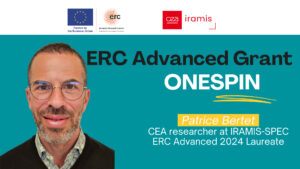This disruptive interdisciplinary project, led by Patrice Bertet, a researcher at SPEC (UMR CEA – CNRS), aims to revolutionise magnetic resonance spectroscopy by pushing it to the scale of the single molecule.
A major European recognition for a CEA researcher
Researcher Patrice Bertet has received an ERC Advanced, one of Europe’s most prestigious scientific distinctions, to support his project ONESPIN. The project aims to push the limits of magnetic resonance spectroscopy to the study of individual molecules, and to develop new magnetic imaging methods with nanometric resolution.
At the CEA, Patrice Bertet works at the Institut Rayonnement Matière – IRAMIS at the DRF, in the Service de Physique de l’État Condensé – SPEC (UMR CEA – CNRS), Quantronics group, where for several years he has been developing innovative methods for detecting and manipulating electron and nuclear spins. Winner of an ERC Consolidator in 2013 CIRQUSS, he is internationally recognised for his scientific work, with more than 70 publications and a strong reputation, as witnessed by the award of the International EPR Society Medal in Physics and Materials Science in 2025.
ONESPIN is a project at the crossroads of fundamental physics and cutting-edge technologies. The project is based essentially on a new type of detector, microwave photon counters, developed by our team at the CEA. Using these ultra-sensitive detectors, cooled to 10mK, our aim will be to measure the magnetic spectrum of individual molecules with high spectral resolution. The project is interdisciplinary in nature, as we hope that the methods developed will have an impact on chemistry, biology and even catalysis.
Patrice Bertet, SPEC researcher, ERC Advanced 2024 laureate.
ONESPIN: pushing the boundaries of magnetic spectroscopy
Magnetic resonance spectroscopy is a widely used technique for studying matter, based on the properties of paramagnetic cores and unpaired electrons. However, this method lacks sensitivity, requiring very large sets of identical objects to detect a signal. This limits spectral resolution when samples have heterogeneous properties.
The ONESPIN project seeks to go beyond this limit, by significantly increasing detection sensitivity to the point of detecting the spin of individual objects, using an innovative method that has recently been developed. This is based on the detection of microwave photons emitted during the radiative relaxation of an individual paramagnetic centre at very low temperature (10 mK), by a microwave photon counter, an ultra-sensitive detector based on a superconducting qubit developed at CEA Saclay.
ONESPIN has a number of objectives:
- Applying this technique to various single paramagnetic centres (organic radicals, molecules containing transition metal ions, enzymes, etc.), and obtaining the first high-resolution spectra of these individual molecules.
- Carrying out hyperfine spectroscopy and imaging of nuclear spins around these centres, which would make it possible to image individual molecules with resolution at the level of a single nuclear spin – an old dream of magnetic resonance spectroscopy.
- Developing nanoscale (10 nm) magnetic resonance imaging of paramagnetic centres in a micrometre-sized sample, by combining magnetic gradients with microwave photon counting detection.
A shared pride at the CEA
Winning an ERC Advanced is a great recognition of the work done in a field as demanding as quantum physics. The ONESPIN project, led by Patrice Bertet at SPEC, is a perfect illustration of our ambition to push further the boundaries of fundamental research, while preparing the technological innovations of tomorrow.
François Daviaud, Director of the Institut Rayonnement Matière – IRAMIS.
A propos de Patrice Bertet
Recipient of an ERC Consolidator in 2013 (CIRQUSS), author of more than 70 publications with over 8000 citations, and recognised by the international community, as illustrated by the Grand Prix Jacques Herbrand from the Académie des Sciences and the 2025 “Physics and Materials” medal from the International Society for EPR Spectroscopy, Patrice Bertet conducts his research at the CEA, in the Fundamental Research Department – DRF, in the Institut Rayonnement Matière – IRAMIS, and in the Condensed State Physics Department – SPEC, Quantronics group. A PhD in quantum physics (2002) and postdoctoral researcher in superconducting circuits, he quickly became a leader in this field by developing innovative methods. Today, his research focuses on single-spin magnetic resonance, a fundamental field that also holds great promise in terms of applications.




